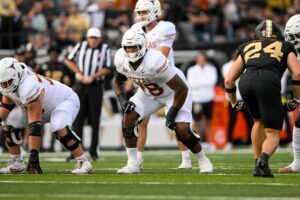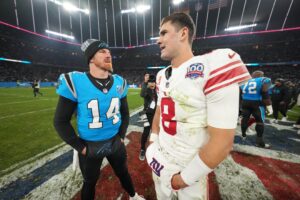The Green Bay Packers are riding high after a victory over the Chicago Bears brings their record to 11-3. The win was much more narrow than it should have been after the Packers took a 21-3 lead shortly into the third quarter. First year head coach Matt LaFleur has turned the win total around, but his vaunted offense hasn’t been much more productive than the dinosaur schemes from Mike McCarthy the past few years. Although the offense currently sits at sixth in DVOA according to Pro Football Outsiders, there is a complete lack of consistency as they rank 13th in points per game. The offense goes dormant for quarters or halves at a time. Some of the more optimistic fans and analysts have begun to wonder if LaFleur is saving his secret sauce for the playoffs. Well, let’s join the optimists. Today, we look at what aspects of the Packers offense have been working this year and how they can be applied in the postseason.
How the Green Bay Packers Offense Can Succeed in the Playoffs
The Run Game
First and foremost, the run game has been this team’s biggest strength. The offense moves as Aaron Jones does. He is the true star of LaFleur’s offense. Aaron Rodgers and Davante Adams continue to provide their obvious star power, but the team’s best performances have come when the offense runs through Jones. Take the Philadelphia Eagles game for example where Rodgers passed for 422 yards with Adams posting ten receptions for 180 yards. The Packers lost due to much dismay about goal-line play-calling. Jones only had 21 yards on the ground in that game but wasn’t given one of the final opportunities to convert the short-yardage situation with the game on the line. Jones has been incredible within the redzone. He has scored an astounding 12 touchdowns on just 30 carries. LaFleur continues to believe in running mate Jamaal Williams on short yardage situations. Although a running back rotation is important to keep both members fresh, Jones has been the far superior option and should continue to be fed carries, especially in the redzone.
We saw many more formations with two running back sets early in the season. Many of these were designed for one player to motion out of the backfield before taking a sweep in the opposite direction. Motioning backs and tight ends was a staple of the early season offense, but there has been a downtick in those calls lately. With LaFleur and Rodgers openly admitting it would take a few weeks for the offense to hit its stride, it seems there has been less creativity over the past month. LaFleur needs to stick to his “all gas, no breaks” approach and continue to utilize motion, jet sweeps, end arounds, and two running back formations for this zone scheme to stay unpredictable like several of the other top rushing teams in the NFC.
Passing Attack
LaFleur really has shown many different alignments in the passing game this season. He has at least mixed in a variety of formations with multiple backs or tight ends. We even saw several three tight end formations in the win over the Washington Redskins. The Packers have had the most success when there is the threat of a run game. The team is averaging over eight yards per attempt with two tight ends and two receivers on the field.
In the off-season, there was a lot of talk about how important the tight end position was to LaFleur’s offense. Jimmy Graham and Marcedes Lewis don’t provide the proper athleticism needed to thrive on their own, but the scheme has done a great job at getting them open anyways. LaFleur should continue to utilize a unique gameplan that features the tight ends in space. He should work towards getting third round rookie Jace Sternberger up to speed in order to inject a bit more athleticism to the offense.
The wide receiver position is the weak point of this entire team. Apart from Adams, there has been very little consistent from this group. Almost every Packer fan realized this could be an issue prior to the season. There was a lot of speculation that a move would be made for a veteran receiver at the trade line. Well, it came and went, and the Packers are still dealing with a cast of misfits at receiver. When Adams suffered a turf toe injury in that same game against the Eagles, it appeared the offense may be doomed. LaFleur crafted up a game plan that spread the ball around and utilized the running backs as primary receivers.
Since Adams’ return, the Packers offense has not been as dominant. Obviously, he brings a skillset unmatched by his peers, but Rodgers needs to get back in the mindset of spreading the ball to whomever is open. One bright spot behind Adams has been second-year pro Allen Lazard. After missing out on the initial 53 roster, Lazard was quickly brought up from the practice squad. After his phenomenal game-winning touchdown against the Detroit Lions in week six, Lazard has continued to be a fixture of the offense. He has more chemistry and trust with Rodgers than established players such as Marquez Valdes-Scantling and Geronimo Allison. He continues to make a play or two down the field in every contest and should be the secondary receiver behind Adams the rest of the season.
Looking Ahead
Both Rodgers and LaFleur commented after the Bears game that this team can continue to “win ugly” all the way to the Super Bowl. They are currently in a great position to qualify for a home playoff game. That means cold weather in Lambeau. This team does have an effective defense and ground game for the first time in years. Luckily this offense scores early in games. Quick starts, a strong run game, and an efficient pass-rush could be this team’s roadmap moving forward. Jones and Williams should carry the workload over the next month. Rodgers and Adams should be utilized as more complimentary pieces. If the tight ends and secondary receivers can make one or two plays a game, this Packers offense can succeed. Continue to feed 33 and 17 and good things will happen.
Main Photo:
Embed from Getty Images






